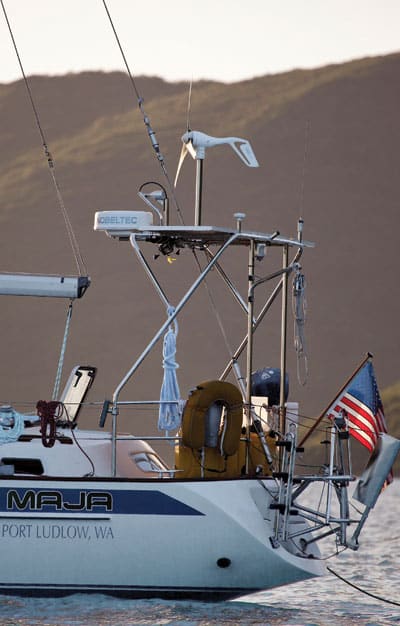
Green Advice
In this concluding installment of CW‘s series on direct-current power systems (check out Part I and Part II), we take a look at how power generation via sunlight, wind, and water has incrementally evolved over, say, the last 10 years. These refinements, coupled with the improved efficiencies of the electrical devices we carry on board, mean that from a systems perspective, reducing our dependence on diesel engines and generators is increasingly possible—up to a point.
The question facing us isn’t “Can we go green?” It’s “How green can we go and still have our toys?” Unrealistic expectations are sure to disappoint, but with the right knowledge, a proper and effective system to supplement or even replace a petro-dependant diesel generator—with its required maintenance, noise, and exhaust fumes—is quite within the realm of possibility.
On Design, Back to Basics
As seemingly high-tech as green power sources appear to be, it’s important to remember that electrical-system design always centers around one fundamental: your “appetite for amps,” as I’ve referred to it many times before. How much power do you need? It all boils down to your desired comfort level and to how many electrical devices you intend to regularly use. This is true whether you’re running a battery-supplied DC system or a high-voltage AC system that relies on shore power or on a generator.
Thirty years ago, when my wife and I were cruising extensively, we were quite happy with a boat that didn’t have even a shore-power system! We loved our quaint gimbaled brass oil lamps when reading at night. Today, our needs are quite different, and having a renewable power supply on board is a must. The question boils down to this: Exactly how much power is enough?
So, much as with the engine-driven alternators and battery chargers that I discussed earlier in this series (see “New Tools for Managing Your Battery Bank,” March 2012), you need to begin by making an honest evaluation of your daily power consumption. Most folks I’ve worked through this drill with tend to go into a bit of denial about how much power they really use, possibly due to the simple reality that power generation costs money. The more electricity you use, the more you’re going to have to invest in equipment.
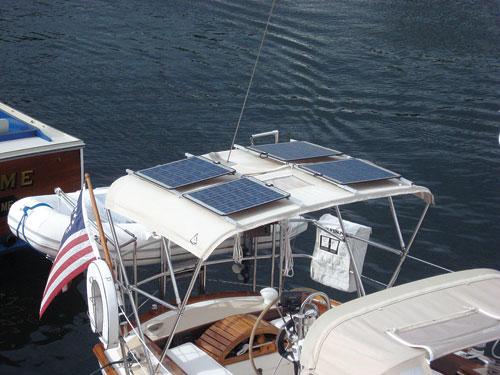
With a typical 100-amp-hour A.G.M. battery priced at $300 or more, every time you add one to your system, it’s going to cost you some real dollars. So an accurate analysis of your electrical needs is always going to be the first step in determining what your system will look like: How big an alternator will you need? How much battery capacity is required? How many watts of solar-panel power can you install? Where on the boat will the panels fit? What about using a wind generator or a water generator when you’re passagemaking?
Answer these questions and you can begin to determine how you can generate enough power in a day to replenish what you will typically use.
Where We Stand
I’m often asked if there have been any significant improvements in efficiency with electrical systems in general, and solar panels in particular, over the last decade. The answers are mixed.
Let’s start on the consumption side of the equation. There have been significant reductions in power consumption over the last 10 years. Think L.E.D. lighting. L.E.D. lights typically use a tenth of the power that a similarly sized incandescent light uses. That’s significant. Combine that with improved battery absorption rates, which enable properly sized and rated charging devices to replenish discharged batteries more rapidly, and you’ll see a genuine uptick in overall efficiency.
In a general sense, in fact, most marine electronic equipment in use today is more electrically efficient than equipment available to us a decade ago. Voltage drop through typical battery and charging systems has been reduced as such system components as battery combiners and isolators have evolved using vastly more efficient electronic control circuits. But while display screens and other devices now consume less power, we tend to use more of them. So when it comes to green power and energy self-sufficiency, the real answer depends on the individual. Again, it’s a question of how much power will you use. Once you have the answer, you can then design a DC system integrating alternative power sources that will require fewer batteries to store the power you’ll consume on a daily basis.
On the supply side, it’s important to remember that the marine alternative-power market is minuscule in the grand scheme of things. Therefore, any improvements in technology are derived from other market sectors, such as land-based recreational vehicles and commercial and home applications in which there’s enough critical mass to entice companies to invest in product improvement and development.
As a result, many of the items you’ll be looking at and considering for your boat are really going to be land-based products. I mention this because it may impact critical choices in material selection. You’ll need to research, for example, whether an aluminum frame for a panel is anodized or not or whether screws are made of stainless steel or merely cadmium-plated mild steel. You’ll need to look for subtle nuances such as these when shopping for and comparing products.
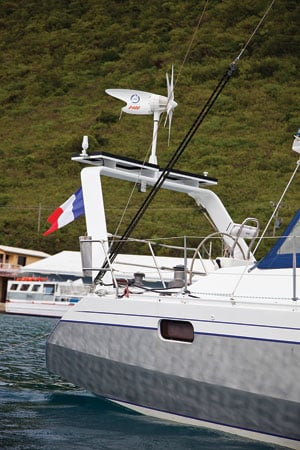
With solar panels, we can narrow things down to three distinct categories and make some general statements regarding relative efficiency and how this impacts pricing.
Monocrystalline solar cells are the most efficient and also offer small improvements in low-light performance. The downside? They’re the most expensive types, but they can offer “efficiencies”—the rate of sunlight conversion—as great as 17 percent.
Polycrystalline panels are available in several variations and, depending on the manufacturing process, offer efficiencies in the 11-percent to 14-percent range.
Amorphous panels, sometimes referred to as “thin film,” are the most common type used with the flexible panels that are quite popular among cruisers. The trade-off for this flexibility is performance; their typical efficiencies are only about 5 percent to 6 percent.
A relatively new category of solar panels has emerged; it’s known simply as Group 3-4. These panels use a variety of materials, such as gallium arsenide, that offer much greater conversion efficiency than the silicon-based cells we commonly see today. These panels offer efficiencies in the range of 25 percent but are presently cost-prohibitive for most sailors.
So to answer the basic question, although we haven’t seen major improvements in actual efficiencies with silicon-based solar panels over the last five years, we have seen a steady decline in prices. This all contributes to a lower cost-per-watt hour. From that perspective, efficiencies have improved. With panels now readily available up to about 85 watts, and with the ability to parallel-connect groups depending upon the limitations of your onboard real estate, we can now generate quite a few amps of power in a given day, as long as the sun shines.
Wind-Power Considerations
Wind power can often take over when the sun goes down or the cloud cover renders a solar array nearly useless. Some of the most popular wind generators can deliver up to 400 watts, or 33 amps, of power at 12 volts.
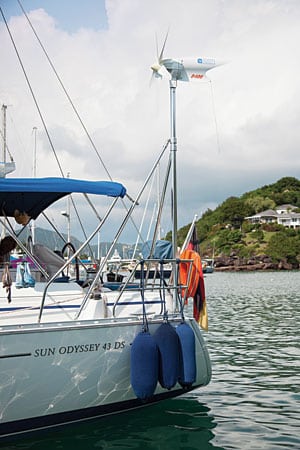
We’ve seen improvements with this technology in the forms of increased low-velocity wind performance and the integration of microprocessor-controlled voltage regulation built into the generator body rather than executed via external regulators. Also, the trend seems to be toward the use of alternators rather than DC generators on more modern units. Alternators are theoretically more efficient. All of these incremental improvements are steps in the right direction.
There are several key things to consider with wind generators, besides theoretical power output. One is how much wind it takes for the unit to kick into action and start delivering useful power. A second factor that I find personally annoying is how much noise the unit generates under average conditions. Not to be ignored, either, is blade diameter and the physical space limitations on your particular boat. You want such a unit to be far away from people on deck under absolutely all conditions!
Remember that you’ll generally attach your wind generator on some sort of pole mount that in turn will be through-bolted to your boat’s deck. This typical structure will act as an amplifier for any noise that the wind generator creates. This can be especially pronounced with units that utilize blade articulation to help slow them down in heavy winds. If you’re weighing the purchase of a wind generator, consider getting on a boat to experience your model in use; at least run a query on this subject at the many alternative-energy websites. I’ve been aboard boats on which the wind-generator noise in a 15- to 20-knot breeze was enough to make me very uncomfortable. Some of the newest units employ electronic overspeed protection that I’ll bet is considerably quieter.
I think the best strategy for selecting a wind generator, in addition to what I’ve mentioned already, is to study carefully the product’s projected performance curve, indicating the power generated at a given wind speed. If the vendor can’t provide you with that data, be suspicious. Make sure to match this curve to your typical wind speeds to get a feel for the total weekly or monthly power-generating capabilities of the unit. If you live in an area of really light air, you may find that the return on your investment here may not work out.
How About a Water Generator?
Cruising hydrogenerators have never been very popular. But I recently inspected a unit that I think might just change that. Made in Europe by Watt & Sea and now available here in the United States through eMarine Systems, these units are really slick!
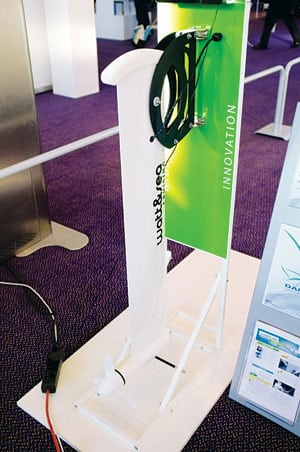
__Consider these numbers: Say the unit delivers 120 watts at 5 knots of boat speed. That works out to 10 amps. Multiply that by the number of hours you maintain that 5-knot speed. In 24 hours, you’ll have generated 240 amp-hours of electrical current. Not too shabby!
Whichever way you go with alternative-energy solutions for your boat, whether it’s all solar, solar plus wind, or solar, wind, and water, keep in mind that you’ll also need to integrate charge controllers and switching systems to maximize your power-generating setup. Also, you may be converting some of the power you generate and store in batteries to AC current via an inverter. The options in this arena are almost endless and a bit complex for the electrically challenged. If you fall into that category, I highly recommend that you consult with an experienced marine electrician. Done properly, an onboard alternative-energy system employing all of the things mentioned here can truly take you a long way away from a petro-based world.
Ed Sherman is the educational programming director for the American Boat & Yacht Council. Read his frequent blog posts in Ed’s Boat Tips.








